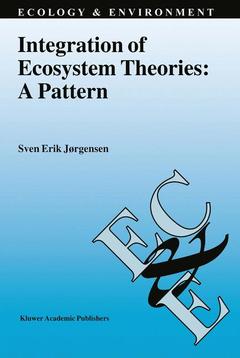Description
Integration of Ecosystem Theories: A Pattern, Softcover reprint of the original 1st ed. 1992
Ecology & Environment Series, Vol. 1
Author: Jørgensen Sven Erik
Language: English
Subjects for Integration of Ecosystem Theories: A Pattern:
Keywords
Approximative price 52.74 €
In Print (Delivery period: 15 days).
Add to cart
Publication date: 10-2012
383 p. · 16x24 cm · Paperback
383 p. · 16x24 cm · Paperback
Description
/li>Contents
/li>
Ecosystems are still a puzzle for mankind. We would like to be able to know their reactions and control them, but repeatedly we have been surprised by their unexpected reactions to our somewhat hasty actions. We unfortunately have to admit that our present knowledge about ecosystems and their true nature is rather limited. Many excellent contributions to a more profound understanding of ecosystems have been launched during the last two decades, but if you do not know the field, it looks as if all the presented ecosystem theories are in complete discord with each other. However, ecosystems are extremely complex and only a pluralistic view will be able to reveal their basic properties. The different approaches therefore have much in common, when you go deeper into the core material, than the first superficial more glance will be able to tell and there is therefore a natural need for a unification of the various approaches to ecosystem theories. It has for many years been my desire to attempt to make a unification of the many excellent thoughts, ideas and observations about ecosystems, that scientists have contributed. These thoughts, ideas and hypotheses have not been made in vain.
1. Introduction: Recent Trends in Science. 2. Do We Need a New, Holistic Ecology? 3. Models in Ecology. 4. Energy and Ecology. 5. Entropy and Ecology. 6. Exergy and Ecology. 7. Network and Hierarchial Concepts of Eco-Systems. 8. Utility Theory, Indirect Effect and Ascendency. 9. Catastrophe Theory and Ecology. 10. Chaos, Fractals and Ecology. 11. Dynamic of Ecosystems. 12. A Tentative Pattern of Ecosystem Theories. 13. Epilogue. 14. Appendix 1. Definitions of Concepts. 15. References. Index.
© 2024 LAVOISIER S.A.S.




